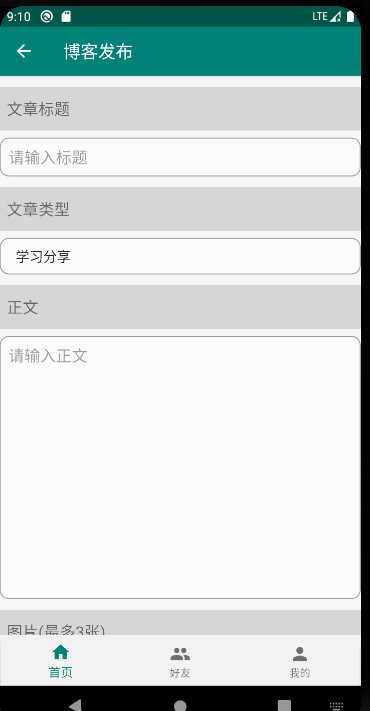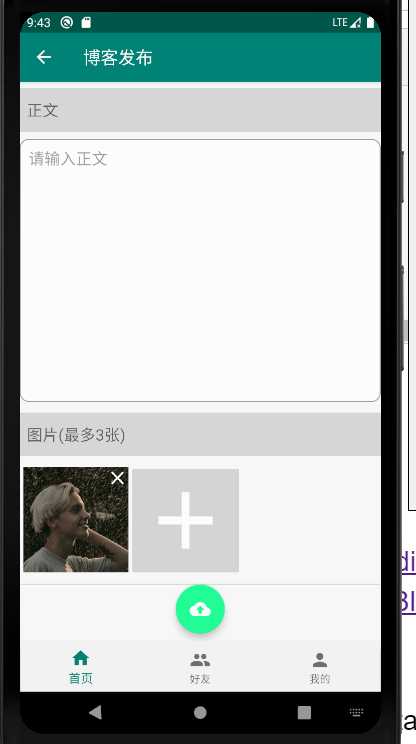标签:baidu width action tor text 报文格式 建立 之间 leo
UI界面设计:


由于博客发布可能附加图片,但是图片(或者任何文件)信息必须放在http请求体的正文之中,这就需要我们使用HttpUrlConnection的时候构建Http正文。
我们先来看一下Http正文格式:
1 POST /api/feed/ HTTP/1.1 2 Accept-Encoding: gzip 3 Content-Length: 225873 4 Content-Type: multipart/form-data; boundary=OCqxMF6-JxtxoMDHmoG5W5eY9MGRsTBp 5 Host: www.myhost.com 6 Connection: Keep-Alive 7 8 --OCqxMF6-JxtxoMDHmoG5W5eY9MGRsTBp 9 Content-Disposition: form-data; name="lng" 10 Content-Type: text/plain; charset=UTF-8 11 Content-Transfer-Encoding: 8bit 12 13 116.361545 14 --OCqxMF6-JxtxoMDHmoG5W5eY9MGRsTBp 15 Content-Disposition: form-data; name="lat" 16 Content-Type: text/plain; charset=UTF-8 17 Content-Transfer-Encoding: 8bit 18 19 39.979006 20 --OCqxMF6-JxtxoMDHmoG5W5eY9MGRsTBp 21 Content-Disposition: form-data; name="images"; filename="/storage/emulated/0/Camera/jdimage/1xh0e3yyfmpr2e35tdowbavrx.jpg" 22 Content-Type: application/octet-stream 23 Content-Transfer-Encoding: binary 24 25 这里是图片的二进制数据 26 --OCqxMF6-JxtxoMDHmoG5W5eY9MGRsTBp--
POST /api/feed/ HTTP/1.1
这一行就说明了这个请求的请求方式,即为POST方式,要请求的子路径为/api/feed/,例如我们的服务器地址为www.myhost.com,然后我们的这个请求的完整路径就是www.myhost.com/api/feed/,最后说明了HTTP协议的版本号为1.1。
Accept-Encoding: gzip
Content-Length: 225873
Content-Type: multipart/form-data; boundary=OCqxMF6-JxtxoMDHmoG5W5eY9MGRsTBp
Host: www.myhost.com
Connection: Keep-Alive
--OCqxMF6-JxtxoMDHmoG5W5eY9MGRsTBp
我们知道HTTP协议采用“请求-应答”模式,当使用普通模式,即非KeepAlive模式时,每个请求/应答客户和服务器都要新建一个连接,完成之后立即断开连接(HTTP协议为无连接的协议);当使用Keep-Alive模式(又称持久连接、连接重用)时,Keep-Alive功能使客户端到服务器端的连接持续有效,当出现对服务器的后续请求时,Keep-Alive功能避免了建立或者重新建立连接。
1 --OCqxMF6-JxtxoMDHmoG5W5eY9MGRsTBp 2 Content-Disposition: form-data; name="lng" 3 Content-Type: text/plain; charset=UTF-8 4 Content-Transfer-Encoding: 8bit 5 6 116.361545
1 Content-Type: text/plain; charset=UTF-8 2 Content-Transfer-Encoding: 8bit
文件参数:
1 Content-Type: application/octet-stream 2 Content-Transfer-Encoding: binary
参数实体的最后一行是: --加上boundary加上--,最后换行,这里的 格式即为: --OCqxMF6-JxtxoMDHmoG5W5eY9MGRsTBp--。
具体代码如下:
1 public static void sendPostImg(String actionUrl, Map<String, File> files) throws IOException { 2 3 String BOUNDARY = java.util.UUID.randomUUID().toString(); //利用系统工具类生成界限符 4 String PREFIX = "--", LINEND = "\r\n"; 5 String MULTIPART_FROM_DATA = "multipart/form-data"; 6 String CHARSET = "UTF-8"; 7 8 URL uri = new URL(actionUrl); 9 HttpURLConnection conn = (HttpURLConnection) uri.openConnection(); 10 conn.setReadTimeout(5 * 1000); // 缓存的最长时间 11 conn.setDoInput(true);// 允许输入 12 conn.setDoOutput(true);// 允许输出 13 conn.setUseCaches(false); // 不允许使用缓存 14 conn.setRequestMethod("POST"); 15 conn.setRequestProperty("connection", "keep-alive"); 16 conn.setRequestProperty("Charsert", "UTF-8"); 17 conn.setRequestProperty("Content-Type", MULTIPART_FROM_DATA + ";boundary=" + BOUNDARY); 18 19 // // 首先组拼文本类型的参数 20 // StringBuilder sb = new StringBuilder(); 21 // for (Map.Entry<String, String> entry : params.entrySet()) 22 // { 23 // sb.append(PREFIX); 24 // sb.append(BOUNDARY); 25 // sb.append(LINEND); 26 // sb.append("Content-Disposition: form-data; name=\"" + entry.getKey() + "\"" + LINEND); 27 // sb.append("Content-Type: text/plain; charset=" + CHARSET + LINEND); 28 // sb.append("Content-Transfer-Encoding: 8bit" + LINEND); 29 // sb.append(LINEND); 30 // sb.append(entry.getValue()); 31 // sb.append(LINEND); 32 // } 33 34 DataOutputStream outStream = new DataOutputStream(conn.getOutputStream()); 35 // outStream.write(sb.toString().getBytes()); 36 InputStream in = null; 37 // 发送文件数据 38 if (files != null) 39 { 40 for (Map.Entry<String, File> file : files.entrySet()) 41 { 42 StringBuilder sb1 = new StringBuilder(); 43 sb1.append(PREFIX); 44 sb1.append(BOUNDARY); 45 sb1.append(LINEND); 46 // name是post中传参的键 filename是文件的名称 47 sb1.append("Content-Disposition: form-data; name=\"file\"; filename=\"" + file.getValue().getName() + "\"" + LINEND); 48 sb1.append("Content-Type: application/octet-stream; charset=" + CHARSET + LINEND); 49 sb1.append("Content-Transfer-Encoding: binary"+LINEND); 50 sb1.append(LINEND); 51 outStream.write(sb1.toString().getBytes()); 52 Log.d("file",sb1.toString()); 53 InputStream is = new FileInputStream(file.getValue()); 54 byte[] buffer = new byte[1024]; 55 int len = 0; 56 while ((len = is.read(buffer)) != -1) 57 { 58 outStream.write(buffer, 0, len); 59 } 60 61 is.close(); 62 outStream.write(LINEND.getBytes()); 63 } 64 65 // 请求结束标志 66 byte[] end_data = (PREFIX + BOUNDARY + PREFIX + LINEND).getBytes(); 67 outStream.write(end_data); 68 outStream.flush(); 69 // 得到响应码 70 int res = conn.getResponseCode(); 71 if (res == 200) 72 { 73 in = conn.getInputStream(); 74 int ch; 75 StringBuilder sb2 = new StringBuilder(); 76 while ((ch = in.read()) != -1) 77 { 78 sb2.append((char) ch); 79 } 80 Log.d(TAG,"状态码:"+res); 81 }else{ 82 Log.d(TAG,"状态码:"+res); 83 } 84 outStream.close(); 85 conn.disconnect(); 86 } 87 // return in.toString(); 88 }
代码是我参考其他博客改的,按照我自己的需求,将一些参数附加到URL后传输,Http正文只传输文件,因为我的参数决定了文件的命名格式,这样后台不用遍历查找参数后在遍历一次寻找文件了,当然,如果你的参数比较重要的话还是将参数写到Http正文中,这样较为安全。
后台文件接收代码:
1 String temppath="C:/Program Files/apache-tomcat-9.0.31-windows-x64/apache-tomcat-9.0.31/tempfile"; 2 String path="C:/Program Files/apache-tomcat-9.0.31-windows-x64/apache-tomcat-9.0.31/webapps/STDEverything/images/blog"; 3 4 String userid=request.getParameter("userid"); 5 String blogid=request.getParameter("blogid"); 6 7 DiskFileItemFactory disk = new DiskFileItemFactory(1024*10,new File(temppath)); 8 ServletFileUpload up = new ServletFileUpload(disk); 9 List<FileItem> list; 10 try { 11 list=up.parseRequest(request); 12 for(FileItem item:list) { 13 if(!item.isFormField()) { 14 InputStream inputStream=item.getInputStream(); 15 String filename=item.getName(); 16 String imgname=userid+"_"+DBUtil.getIdentifier()+"_"+filename; 17 OutputStream outputStream=new FileOutputStream(path+"/"+imgname); 18 System.out.println(imgname); 19 int len=0; 20 byte buff[]=new byte[1024]; 21 while((len=inputStream.read(buff))!=-1) { 22 outputStream.write(buff,0,len); 23 } 24 outputStream.flush(); 25 outputStream.close(); 26 inputStream.close(); 27 DBUtil.writeBlogImg(request.getRequestURL().substring(0,request.getRequestURL().lastIndexOf("/")) 28 +"/images/blog/"+imgname, blogid); 29 }else { 30 System.out.println(item.getFieldName()); 31 } 32 } 33 } catch (FileUploadException e) { 34 // TODO Auto-generated catch block 35 e.printStackTrace(); 36 response.getWriter().write("no"); 37 } 38 response.getWriter().write("yes");
要想运行上文中的代码接收文件,需要导入两个jar包,
链接:http://pan.baidu.com/s/1jIbyn5s 密码:84se
关于后台接收文件的学习可以参考这篇博客:
值得一提的是,当传输文件时,你的Http正文编码格式必须改为"multipart/form-data",然而改为这种格式之后,普通的request.getParameter方式就无法获取参数了,但可以获取fileitem.InputStream来进行转换,这也就是上文中说的为什么要遍历获取参数的原因。
至于Android项目的后期设想,因为博客图片是和博客id进行绑定的,而且我存进去的是该图片的网址,当后期显示博文的具体内容时,可以先请求下来博客网址信息,用Android的Glide插件异步加载图片。
Android项目——HttpUrlConnection上传文件(图片)
标签:baidu width action tor text 报文格式 建立 之间 leo
原文地址:https://www.cnblogs.com/haheihei/p/12686497.html